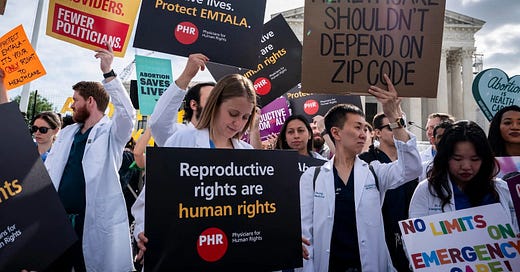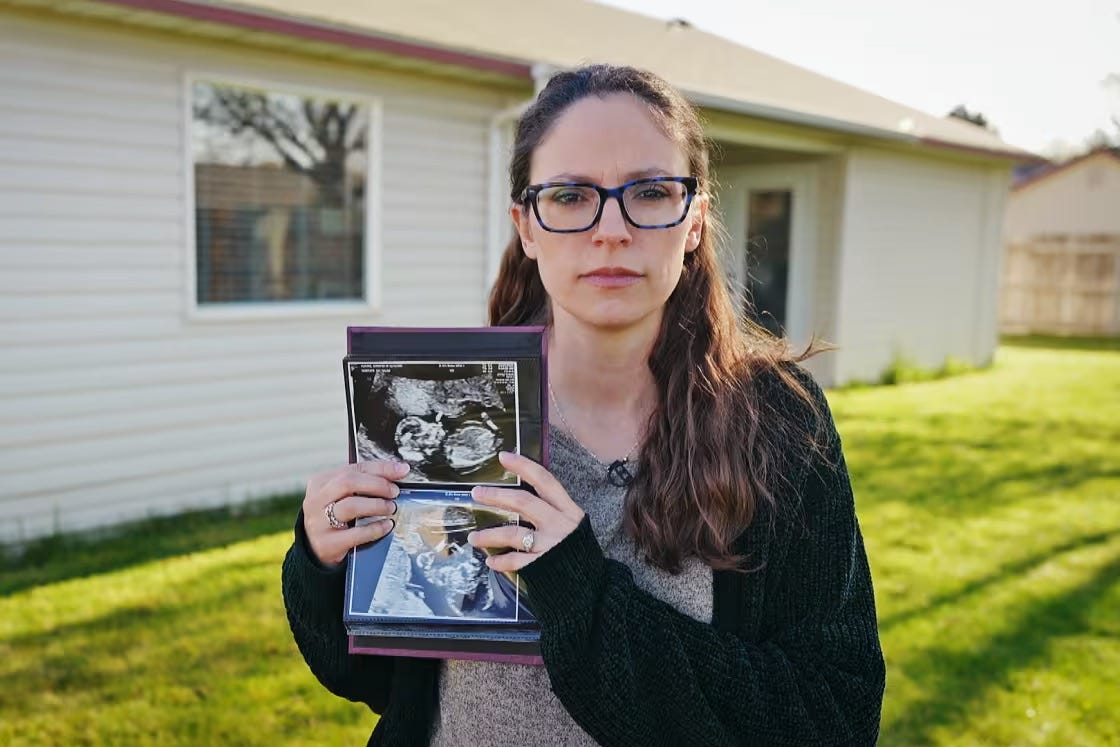What the recent Supreme Court abortion arguments reveal about Conservative's litigation strategy
“The hospital must stabilize the threat to the unborn child, and it seems that the plain meaning is that the hospital must try to eliminate any immediate threat to the child, but performing an abortion is antithetical to that duty” - Justice Samuel Alito
“In Idaho, doctors have to shut their eyes to everything except death … Whereas under EMTALA, you’re supposed to be thinking about things like, ‘Is she about to lose her fertility? Is her uterus going to become incredibly scarred because of the bleeding? Is she about to undergo the possibility of kidney failure?’”- Solicitor General Elizabeth B. Prelogar
On Wednesday of last week, the Supreme Court heard oral arguments in a case about whether doctors can provide abortion as stabilizing care, or put another way: can doctors provide an abortion when a pregnant person *might* die (or be seriously harmed) but not *will* die?
This ruling could impact 22 states with abortion restrictions, in particular the six states that don’t include an exemption for the health of the mother. The decision is expected to come down in late June or early July.
Under Idaho law, abortion is only allowed to prevent the death of the mother (not self-inflicted) or in the case of rape that has been reported to law enforcement and is in the first trimester, or if the pregnant person is a minor, in the case of rape or incest that has been reported to law enforcement or CPS. (A note: this January one Idaho Senator proposed repealing the rape and incest exceptions.)
The DOJ and physicians sued Idaho, saying this ban conflicts with, and is preempted by, the obligations that emergency room doctors have under the Emergency Medical Treatment and Labor Act (EMTALA) in situations where an abortion is necessary stabilizing treatment for an emergency medical condition.
My Analysis of Oral Arguments:
As if the core issue itself isn’t ghastly enough, we got two indications of conservative’s impact litigation strategy from this case:
Path to a Constitutional ban on abortions (ie: constitutional fetal personhood)
We know Alliance Defending Freedom (ADF) helped Idaho in this case and they exist for the express purpose of using litigation to shape the country to their Christian ideology. I often argue that their ultimate goal is to grow case law so they can successfully make the argument that the 14th Amendment includes the life of a fetus from the moment of conception - therefore granting an embryo onwards all protections offered to a person. (ADF CEO Kristen Waggoner recently confirmed this “We do believe at ADF that the Constitution protects the life of an unborn child and that that is in the 14th Amendment.”) You may recall that the Alabama Supreme Court ruled that frozen embryos were unborn “extrauterine children” based on a law drafted by ADF.
The argument Idaho makes in this case is that the fetus is a separate patient of the ER. Idaho’s lawyer Josh Turner said “Congress under EMTALA recognizes that there are two patients to consider in those circumstances. And the two-patient scenario is tough when you have these competing interests.”
Justice Neil Gorsuch and Justice Samuel Alito asked questions along these lines.
Gorsuch: “What do we do with the EMTALA’s definition of individual to include both the woman and, as the statute says, the unborn child?”
Alito: “One potentially very important phrase in EMTALA” had hardly been mentioned, which is “EMTALA’s reference to the woman’s ‘unborn child.'” He inquired, “Isn’t that an odd phrase to put in a statute that imposes a mandate to perform abortions?” And he also said “ “Certainly you wouldn’t dispute the fact that the hospital has a duty to the unborn child.”
The U.S. Solicitor General Elizabeth Prelogar countered that Alito’s was an “erroneous reading” of the law and that Congress added “unborn child” to EMTALA in order to expand protections for pregnant people, not reduce them. The term was added in 1989 after reports of hospitals refusing to treat women whose own health or lives weren’t in danger, but whose fetuses were in distress and needed medical care. When women face a medical emergency, they are the patient under EMTALA, not the fetus, but in a situation where it is the fetus that is facing imminent harm, she still needs to receive emergency care.
19 states already have fetal personhood language in their laws.
In the Dobbs majority opinion, Alito made clear that he was already thinking about fetal personhood, and in particular disputes the liberal justices contention that there *isn’t* fetal personhood in the constitution:
“Our opinion is not based on any view about if and when prenatal life is entitled to any of the rights enjoyed after birth. The dissent, by contrast, would impose on the people a particular theory about when the rights of personhood begin. According to the dissent, the Constitution requires the States to regard a fetus as lacking even the most basic human right—to live—at least until an arbitrary point in a pregnancy has passed. Nothing in the Constitution or in our Nation’s legal traditions authorizes the Court to adopt that “‘theory of life.’”
Gender affirming healthcare
Some of the conservative justices, notably Gorsuch, implied that they don’t know why the case had reached the Supreme Court because the federal government has the power to sanction hospitals that don’t provide all forms of emergency care required by federal law and can even cut those hospitals off from the Medicare program. Clarence Thomas asked questions about how federal laws passed under the spending clause can supersede state criminal laws. This conversation then went into how far federal laws made under the spending clause can go. Amy Coney Barrett asked if it would be possible for Congress to say that any hospital cannot perform abortions or that a Congress could ban any state receiving funds from providing “gender reassignment surgery.”
Justice Gorsuch argued that the logical extension of Prelogar’s arguments is that, yes, Congress could prohibit “gender reassignment surgeries across the nation,” and that “it could ban abortion across the nation.”
Idaho resident Jennifer Adkins had to go to Oregon to receive abortion care after she learned of a diagnosis that would put her life at risk.
The core argument of the case (to me) was “Might Die” versus “Will Die”
The liberal justices on the Court, especially Justices Sonia Sotomayor and Elena Kagan, cited several real world examples in which pregnant women experiencing sepsis, hemorrhage and other serious conditions were refused abortion care in states with bans.
Sotomayor described cases in which there is a preterm premature rupture of membranes (PPROM), a highly severe pregnancy condition that occurs when someone’s water breaks early and for which the standard of care is abortion. Kagan spoke of the increasing use of emergency out-of-state transfers in Idaho as the “appropriate standard of care in Idaho, but it can’t be the right standard of care to force somebody onto a helicopter.” (Prelogar noted that one hospital system in Idaho is having to transfer pregnant women in medical crises out of the state every other week.)
When faced with these real world examples by Sotomayer and Kagan, Idaho’s lawyer Turner tried to argue that there is no conflict between Idaho’s abortion ban and EMTALA because both allow doctors to provide abortions in life-or-death situations but he wasn't able to specify what would happen when different doctors could reach different conclusions about if a women will or might die.
Turner eventually said that the discretion on whether to prosecute a doctor under these circumstances would be left up to prosecutors. Turner also “explained that the state’s Board of Medicine oversees the licensing of Idaho physicians, and that the board looks at whether a doctor made the decision in good faith.”
Justice Amy Coney Barrett was surprised to hear that Turner couldn’t answer these questions or give specifics because Idaho had given assurances to the lower courts that doctors wouldn’t be prosecuted for performing abortions to treat a range of conditions that can lead to serious health consequences. “I’m kind of shocked, actually, because I thought your own expert said below that these kinds of cases were covered” by the exception for conditions that could cause death, she said. “And now you’re saying they’re not.”
U.S. Solicitor General Elizabeth Prelogar said that EMTALA is intended to ensure hospitals do not deny treatment to patients who arrive at the emergency room and, in cases in which there is no other way to prevent a pregnant woman’s health from deteriorating, abortion is the appropriate care that Idaho hospitals must provide, even if the state can enforce its ban in every other circumstance.





